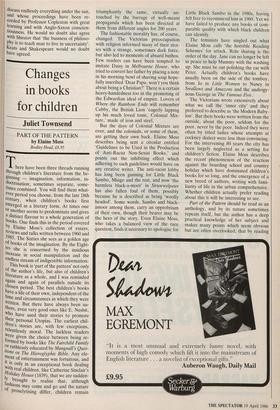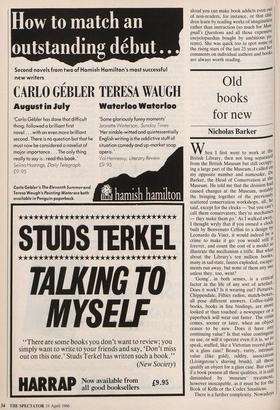Changes in books for children
Juliet Townsend
PART OF THE PATTERN by Elaine Moss
Bodley Head, £8.95
There have been three threads running through children's literature from the be- ginning — imagination, information, in- doctrination; sometimes separate, some- times combined. You will find them what- ever period you choose, from the late 18th century, when children's books first emerged as a literary form. At times one or another seems to predominate and gives a distinct flavour to a whole generation of books. One finds this in the period covered by Elaine Moss's collection of essays, reviews and talks written between 1960 and 1985. The Sixties she sees as a golden age Of books of the imagination. By the Eight- ies she is concerned by the insidious increase in social manipulation and the endless stream of indigestible information. This book is 'part of the pattern' not only Of the author's life, but also of children's literature as a whole, and I was reminded again and again of parallels outside its chosen period. The best children's books have a life of their own, independent of the time and circumstances in which they were written. But there have always been au- thors, even very good ones like E. Nesbit, who have used their stories to promote their personal Utopias. The earliest chil- dren's stories are, with few exceptions, relentlessly moral. The luckless readers were given the choice between being re- formed by books like The Fairchild Family or ruthlessly educated by Mangnall's Ques- tions or The Hieroglyphic Bible. Any ele- ment of entertainment was fortuitous, and it is only in an exceptional book dealing with real children, like Catherine Sinclair's Holiday House (1839), that we are sudden- 1Y brought to realise that, although fashions may come and go and the nature of proselytising differ, children remain triumphantly the same, virtually un- touched by the barrage of well-meant propaganda which has been directed at them from different angles for 200 years.
The fashionable morality has, of course, changed. The Victorian preoccupation with religion informed many of their stor- ies with a strange, sometimes dark force, but also led to moments of absurd bathos. Few readers can have been tempted to imitate Daisy in Melbourne House, who tried to convert her father by placing a note in his morning bowl of shaving soap hope- fully inscribed 'Dear Papa, won't you think about being a Christian?' There is a certain heavy-handedness too in the promoting of the Edwardian ideal of empire. Lovers of Where the Rainbow Ends will remember Cubby, the British Lion 'eagerly lapping up his much loved tonic, Colonial Mix- ture,' made of iron and steel.
But the days of Colonial Mixture are over, and the colonials, or some of them, are getting their own back. Elaine Moss describes being sent a circular entitled 'Guidelines to be Used in the Production of Anti-Racist Non-Sexist Books,' and points out the inhibiting effect which adhering to such guidelines would have on any creative writer. The anti-racist lobby has long been gunning for Little Black Sambo, Mingo and the rest, and now 'the harmless black-a-moor' in Struwwelpeter has also fallen foul of them, possibly because he is described as being 'woolly headed'. Some words, Sambo and black- amoor among them, carry an opprobrium of their own, though their bearer may be the hero of the story. Even Elaine Moss, who takes a balanced view of the race question, finds it necessary to apologise for Little Black Sambo in the 1980s, having felt free to recommend him in 1960. Yet we have failed to produce any books of com- parable quality with which black children can identify.
The feminists have singled out what Elaine Moss calls 'the horrible Reading Schemes' for attack. Role sharing is the order of the day. Jane can no longer be left in peace to help Mummy with the washing up. She must be out polishing the car with Peter. Actually children's books have usually been on the side of the tomboy, from Jo in Little Women to Nancy in Swallows and Amazons and the androgy- nous George in The Famous Five.
The Victorians wrote extensively about what we call the 'inner city' and they preferred to describe as 'the Modern Baby- lon'. But their books were written from the outside, about the poor, seldom for the poor, never by the poor. Indeed they were often by titled ladies whose attempts at cockney dialect were less than convincing. For the intervening 80 years the city has been largely neglected as a setting for children's fiction. Elaine Moss describes the recent phenomenon of the reaction against the boarding school and country holiday which have dominated children's books for so long, and the emergence of a new breed of authors, writing with fami- liarity of life in the urban comprehensive. Whether children actually prefer reading about this it will be interesting to see.
Part of the Pattern should be read as an anthology, and by its nature sometimes repeats itself, but the author has a deep practical knowledge of her subject and makes many points which seem obvious but are often overlooked; that by reading aloud you can make book addicts even out of non-readers, for instance, or that chil- dren learn by reading works of imagination rather than instruction (so much for Man' gnall's Questions and all those expensive encyclopaedias bought by ambitious Pa' rents). She was quick too to spot some of the rising stars of the last 25 years and her comments on individual authors and books are always worth reading.



















































 Previous page
Previous page